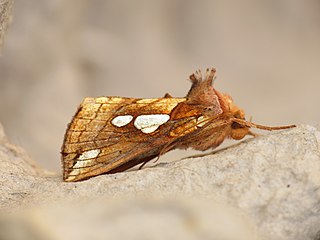
Hemaris thysbe, the hummingbird clearwing, is a moth of the family Sphingidae (hawkmoths). Coloration varies between individuals, but typically the moth is olive green and burgundy on its back, and white or yellow and burgundy on the underside. Its wings are transparent with a reddish-brown border. It has light-colored legs, which combined with the lack of striping on the underside is diagnostic. Beating its wings rapidly, H. thysbe hovers to collect nectar from a variety of flowers. The combination of its appearance and its behavior commonly leads to it being confused with a hummingbird or bumblebee.
Spectroreta is a monotypic moth genus belonging to subfamily Drepaninae erected by Warren in 1903. Its only species, Spectroreta hyalodisca, was described by George Hampson in 1896.

Clytie illunaris is a moth of the family Erebidae first described by Jacob Hübner in 1813. It is found in France, Spain, North Africa and the Arabian Peninsula.

Plusia putnami, the Lempke's gold spot or Putnam's looper moth, is a species of moth of the family Noctuidae. It is found in the Palearctic realm, from Japan and eastern Siberia to Fennoscandia, Great Britain, and France. In North America, it ranges from Newfoundland and Labrador to central Alaska and the interior of British Columbia, south to Pennsylvania, Washington, north-eastern California, and in the Rocky Mountains to Utah and Colorado.

Orthosia gracilis, the powdered Quaker, is a moth of the family Noctuidae. It is found in all of Europe except the extreme north and south, then east across the Palearctic to Northern Asia and Central Asia. O. g. pallidior is described from Xinjiang in China.

Exaeretia allisella is a moth of the family Depressariidae. It is found in most of northern and central Europe, Siberia, the Russian Far East, Mongolia and northern and central China.

Exaeretia is a moth genus of the superfamily Gelechioidea. It is placed in the family Depressariidae, which is often – particularly in older treatments – considered a subfamily of Oecophoridae or included in the Elachistidae.

Glaucocharis lepidella is a species of moth in the family Crambidae. It was described by Francis Walker in 1866. It is endemic to New Zealand and is found in both the North and South Island. The species inhabits lowland to subalpine native forest. Larvae may feed on mosses. Adults are on the wing from November to February and are attracted to light.
Exaeretia canella is a moth in the family Depressariidae. It was described by August Busck in 1904. It is found in North America, where it has been recorded from California, Washington, from British Columbia to Quebec, Idaho, Colorado, Montana, Wyoming, Michigan, New Hampshire, New York and Connecticut.
Exaeretia fulvus is a moth in the family Depressariidae. It was described by Lord Walsingham in 1882. It is found in North America, where it has been recorded from New Brunswick and Maine to British Columbia, south to Arizona and New Mexico.
Exaeretia hildaella is a moth in the family Depressariidae. It was described by John Frederick Gates Clarke in 1941. It is found in North America, where it has been recorded from Alberta and the Northwest Territories.
Exaeretia indubitatella is a moth in the family Depressariidae. It is found in Mongolia and Russia.
Exaeretia nechlys is a moth in the family Depressariidae. It is found in North America, where it has been recorded from Arizona to California and in Nevada.
Exaeretia nivalis is a moth in the family Depressariidae. It is found in North America, where it has been recorded from Montana, Wyoming, Washington, British Columbia and Alberta.
Exaeretia scabella is a moth in the family Depressariidae. It is found in North America, where it has been recorded from Ohio.
Exaeretia sordidella is a moth in the family Depressariidae. It is found in North America, where it has been recorded from British Columbia.
Exaeretia thoracefasciella is a moth in the family Depressariidae. It is found in North America, where it has been recorded from California to Washington.
Exaeretia thoracenigraeella is a moth in the family Depressariidae. It is found in North America, where it has been recorded from California and Oregon.
Exaeretia umbraticostella is a moth in the family Depressariidae. It is found in North America, where it has been recorded from South Dakota and British Columbia to Texas and California.
Gracilanja is a monotypic moth genus in the family Eupterotidae erected by Thierry Bouyer in 2011. Its single species, Gracilanja gracilis, was described by Francis Walker in 1855. It is found in Cameroon, the Republic of the Congo, the Democratic Republic of the Congo, Equatorial Guinea, Ghana, Sierra Leone and Uganda.





